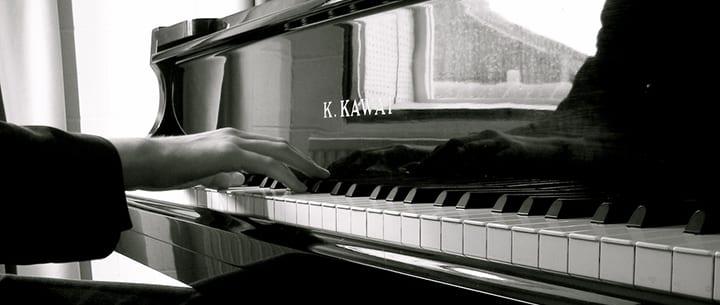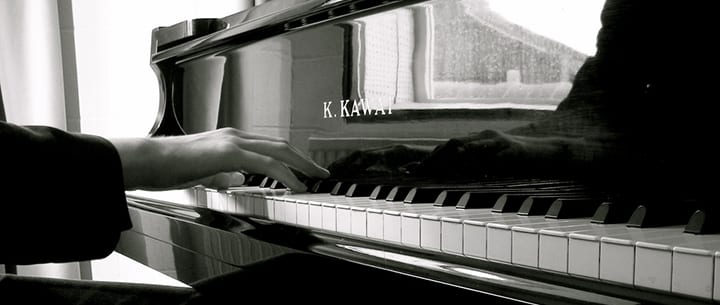Should you reduce or alter your piano practice if your hands, back, or arms hurt? Here are some guidelines to follow from Rosedale, MD teacher Theresa D…
Despite how it may seem, you don’t have to be in pain to play the piano. In fact, with the right posture and some simple stretching exercises, anyone can play without discomfort as they practice the piano.
However, if you find yourself struggling with pain while playing, there are still plenty of ways to work around it and continue practicing. Here are a few tips on how to practice piano when your hands, back, or arms hurt.
What is the Best Way to Practice Piano?
There’s no one answer to the question of how to best practice piano. It depends on your goals, your level of experience, and your available time. However, there are some general tips that can help you make the most of your practice sessions.
- First, set realistic goals for each practice session. If you’re just starting out, don’t try to learn an entire song in one sitting. Instead, focus on mastering a small section. As you become more experienced, you can increase the amount of material you learn in each session.
- Break down complex tasks into smaller steps. For example, if you’re learning a new piece of music, start by practicing one measure at a time. Once you’ve mastered that, put two measures together, and so on.
- Create a practice schedule and stick to it as best you can. Practicing every day is ideal, but if that’s not possible, aim for at least four or five times a week.
- Make sure to warm up before you start practicing. A few minutes of basic exercises will help get your fingers ready for the more challenging tasks ahead.
By following these tips, you can make the most of your practice sessions and quickly improve your skills.
Here’s a video with some simple tips to help you exercise those fingers (and be sure to sign up for piano lessons to learn even more helpful tips!):
https://www.youtube.com/watch?v=ah-fdExgBrY
Can You Over Practice Piano?
As any musician knows, practice is essential to developing skill on an instrument. However, it is possible to have too much of a good thing.
Over-practicing can lead to boredom, burnout, and even injury. When it comes to piano playing, moderation is key. It is important to find a balance between practicing enough to improve and avoiding excessive repetition.
One way to gauge whether you are over-practicing is to pay attention to your motivation. If you find yourself dreading practice sessions or feeling anxious about making mistakes, it may be time to take a break. In addition, watch out for physical signs of over-practice, such as sore muscles or calluses on your fingers.
If you notice any of these red flags, it’s time to cut back on your practice schedule.
By striking a balance between practice and rest, you can ensure that your piano playing stays enjoyable and injury-free.
How to Practice Piano When You’re Hurting
Practicing piano can be a very enjoyable experience for most people, but what if you are in pain or it is difficult for you to play? If you are learning how to play for the first time or if you just want to keep the music under your fingers, regular piano practice is important. But as you get older your body doesn’t always allow you to do so. Keep in mind that you should listen to what your body is telling you. You may want to edit your routine or how you are playing to make practicing more enjoyable. Here are some ideas for possibly eliminating the pain altogether if it is related to how you are playing piano.
Check Hand Position
If your hands are tired or sore, you may want to check your hand position. Your wrist should be off of the keyboard and not resting on the instrument. Wrist should be straight and relaxed. Your fingers should be rounded as if you are holding a ball. When you play with straight fingers, they will be slower and get more tired faster than if they were curved. A good way to make sure that your fingers are in a relaxed curve is to try holding your hand in the air straight in front of you and relax all of your fingers as if your hand is limp. Your fingers will naturally rest in the best position to play piano.
Stiff arms usually mean that you are either too close or too far from the piano keys. Adjust your seat so that your elbows are about a 90-degree angle (when both hands are placed in C position).
Reposition to Resolve Back Issues
One of the most common causes of pain while playing the piano is poor posture. If you hunch over the keys or sit too low or too high at the bench, you’re putting unnecessary strain on your back and shoulders.
Back issues can be the result of many things, but here are a couple suggestions that you can try if it is bothering you:
Take Time to Stretch
Stretching is another great way to prevent pain while playing the piano. Simply taking a few minutes before and after your practice sessions to stretch your arms, shoulders, neck, and back can make a world of difference. Just be sure not to overdo it—stretching too far or too aggressively can actually cause more harm than good. If you’re not sure how to stretch properly, talk to a doctor or physical therapist who can show you some safe and effective exercises specific for piano players.
Take a stretch break. Get the blood flowing in your arms, shoulders, neck, and back. Sometimes we tense up when we are playing without realizing it, making our bodies feel tired or sore. Try rolling your shoulders, bending down, or even twisting from side to side.
Breaking up your practice into shorter times gives your body a chance to relax between practice sessions. Instead of practicing for an hour at a time, try practicing for 10 or 15 minutes at a time, but more often. Remember that it is not how much you practice, but the quality of the practice that matters most.
Use a Hand Pillow or Gloves
If you find that your wrists are starting to hurt while playing, try using a hand pillow or gloves. These devices will help support your wrists and keep them in a neutral position while you play. Hand pillows can be especially helpful if you suffer from carpal tunnel syndrome or other wrist pain conditions.
Using Practice to Help You Heal
If you have a hand injury, one way to heal faster is to increase blood flow. Playing piano exercises like scales or even just the first five notes of the scale can be beneficial. For example: with either hand or both, use the fingering of 1 2 3 4 5 4 3 2 1 and repeat. This can also help when trying to relearn how to use your fingers and regaining dexterity after an accident or injury.
If you have physical limitations, you can still play the piano. I taught a student in the past who did not have feeling in his left hand pinky finger. The solution for him was to learn to play only using the other four fingers. We changed fingerings to suit his physical abilities. For example, instead of the scale fingering for the C scale as 5 4 3 2 1 3 2 1, we changed it to 4 3 2 1 4 3 2 1.
“Hey Doc, It Hurts When I Do This?” Pay Attention to the Pain!
It is amazing that one small thing can affect so much. For instance, changing a pair of shoes can eliminate a pain in your back or neck. Just by having the right support you can save yourself a lot of other issues. Pay attention and remember… If it hurts when you do something, don’t do it. Find another way and don’t give up.
How Many Hours a Day Should You Practice Piano?
The amount of time you should spend practicing piano each day depends on several factors, including your goals, your current skill level, and how much time you have available.
If you are just starting out, it is important to set aside at least 30 minutes a day to practice. As you become more experienced, you can increase the amount of time you spend practicing to 60 minutes or more.
However, even if you only have a few minutes to spare, you can still make progress by using those minutes wisely. The key is to focus on quality over quantity and to practice with intention. Keep a piano practice log of what you want to practice on.
For example, rather than mindlessly running through scales, take the time to focus on your technique and really hone in on the sound you are making. With a little bit of practice each day, you will be amazed at how quickly your skills improve.
What Should Beginners Practice on Piano?
If you’re just starting out on piano, there are a few things you should focus on practicing. First and foremost, it’s important to get comfortable with the basic stretch of your hands. You can do this by practicing simple scales and chords.
Once you’ve mastered these basics, you can start to experiment with more complex pieces of music. The most important thing is to have fun and enjoy the process!
If you find yourself struggling with pain while playing the piano, don’t despair—there are still plenty of ways to continue practicing without discomfort. By changing your posture, using supportive devices like hand pillows or gloves, and stretching regularly, you can lessen the amount of pain you feel while playing and focus on improving your skills instead.
Ready to take your piano playing to the next level – ideally, pain-free? Be sure to sign up for piano lessons soon!
Theresa D. teaches piano, guitar, percussion, and more in Rosedale, MD. She has been teaching for the past 18 years. Learn more about Theresa here!
Photo by alexanderward12
Suzy S.



